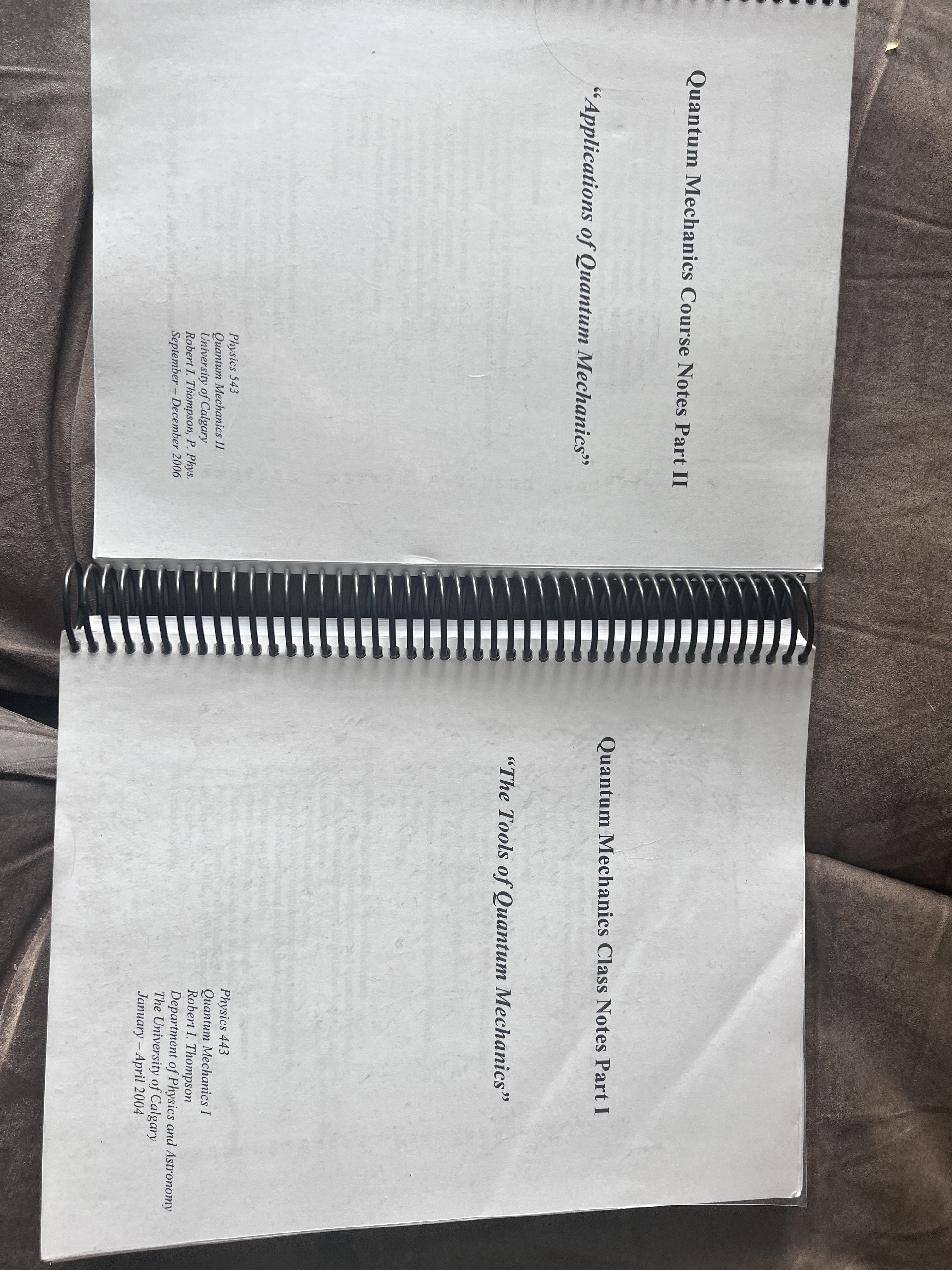My only guess as to what this could mean is that since quantum mechanics is quantum, i.e. discrete, the universe therefore cannot be continuous as the reals are. But this is a category error. Just because you could never find an object that is, say, exactly pi meters long, does not mean that the definition of pi is threatened. There’s nothing infinite that we can observe, but infinity is still a useful concept. And it works both ways; just because quantum mechanics is our best model of the universe doesn’t mean the universe is therefore quantum. 150 years ago everyone believed the universe was like a big clockwork mechanism, perfectly deterministic, because Newtonian physics are deterministic. And who knows, maybe they were right, and we just don’t have the framework to understand it so we have a nondeterministic approximation!
We could make an object that is exactly pi meters long. Make a circle of 1 meter in diameter, and then straighten it out. We would not be able to measure the length more accurately than we can calculate it (that might be the largest understatement ever) but to the tolerance with which we could make a 1 meter diameter circle, you should have the same tolerance to the circumference being pi.
Two issues:
- Planck length The resolution of the circle would be too low to be precisely pi. (I’m not sure whether everything moves only in Planck lengths or whether we live in a voxel world but either way it’s not as precise as however many digits of pi we know.
- Matter waves Assuming that the circle has energy (which it must due to Heisenberg’s uncertainty principle(I haven’t actually read this but I assume that like a vacuum according to the unruh effect matter can’t be devoid of energy)) the particles making up that circle would have a wavelength in which they can interfere with other particles and also have an area in which they might be.
I mean, you only need 39 digits of pi to calculate the circumference of a circle with a diameter the size of the universe to the width of a hydrogen atom. So no matter how detailed you get it’s impossible to determine if a circles circumference is anywhere close to exactly pi.
To ops point, you could set up your thing theoretically and we can math out that it should be pi. But we could not make that object.
Sure. But how about a plank length instead of width of H atom. That would be great.
Right, by my point is that your accuracy and precision are the same whether you are making a 1 meter length object or a π meter length object. Your meter stick is not accurate to the width of a hydrogen atom, either.
But if we accept the precision of our manufacturing capabilities as “close enough,” then it is equally as close to exactly π as it is to exactly 1.
In other words, to say we cannot make an object that is π meters is to say we cannot make an object that is any specific length.
Not to reiterate what other people have said here. But you can make an object 1 meter long by defining that object as 1 meter (hell, you don’t have to, but you can define 1 meter as the length that light travels in a specific amount of time or something silly). Then, to create something two meters long, you can have two of those one-meter lengths. To make something π meters long, you would need infinite precision, that is not true for 1 meter or even 1/3 as you mention later in this thread.
There is no way to divide anything into exactly π length. There is an easy way to divide something into a number that can be expressed as a fraction, such as 1/3, or any fraction you care to come up with, even if it can be represented as .3 repeating.
The precision of our manufacturing capabilities might be limited as QM has this discreete nature. It might be limited in this universe. So pi may only exist theoretically
But you could make that same argument for a lot of fractions. 1/3 doesn’t exist because you cannot divide a quantum in three. 0.333 repeating means that eventually you have to divide an indivisible foundational particle in thirds.
You can divide a thing made up of any multiple of 3 number of things into three. Say, divide twelve eggs by three that’s four eggs, rational division is justified by “I could have multiplied some numbers beforehand so now I can divide”, it’s the inverse of multiplication, after all.
But that only applies to rationals: The issue is that there’s no integer you could multiply pi with that would result in an integer… otherwise pi would be a rational number which it isn’t.
The other guy said good about one out of three known particles. That’s what make it rational!
The problem is that something that doesn’t exist in our universe or reality doesn’t disprove anything in mathematics. Mathematics is abstract. It is rules built up on rules. It does not care about reality or anything
If you have three particles, 1/3 of that is one particle. No need to divide an indivisible particle.
But if I don’t have three particles, 1/3 requires division.
No, by our current understanding there is no length smaller than a Planck length, and any distance must therefore be divisible by an integer. That is, the length is made up of discrete quanta. Pi, or any other irrational number, is by definition not divisible by an integer, or it would be a ratio, making it rational. This has nothing to do with the accuracy or precision of our measures.
Planck length isn’t the smallest possible distance. It’s simply the smallest distance at which our current understanding of physics still holds up. Beyond that, our current models break down, but our current models are very incomplete
Mmmmmm don’t know about that.
The Planck length is the minimum resolvable accuracy of the universe. That doesn’t mean it’s a building block like the electron is.
I believe you’re mistaken. A Planck length is the minimum length we can extrapolate down before physics gets weird, but that doesn’t mean it is the smallest possible length anything can be.
And an irrational number does exist as a discrete unit, it simply cannot be described as a fraction. Case in point, if you could create a spherical particle that was exactly 1 Planck length across, it would have a circumference of exactly π Planck lengths.
By your logic, such a theoretical particle could not exist because the circumference includes an irrational number in the size of the body.
There is no fact about reality that can ever threaten facts about mathematics. Mathematic definitions exist independent of reality.
In fact, you can build a system of definitions that very clearly doesn’t exist in real world, like hyperbolic geometry.
Sometimes we find that obscure pure mathematics does describe reality when no one expected it to. Riemannian geometry is one such example.
Complex numbers, and a bunch more things too
Kurt Gödel:

But irrational numbers aren’t the same as imaginary numbers. Also, there are irrational imaginary numbers. And quantum physics loves using imaginary numbers. So that sentence in the image is nonsense, right?
“Imaginary” was merely poor word choice from long ago.
The definition of irrational numbers is that they are the real numbers that are not rationel. So we need to look at the definition of real numbers. A real number is a number that can be used to measure a continuous one dimensional quantity.
Quantum physics says that reality is not continuous. Particles make “discrete” jumps instead of moving continuously. So irrational numbers can’t exist.
That is not a definition of the real numbers, quantum physics says no such thing, and even if it did the conclusion is wrong
Let’s have a look.
https://en.m.wikipedia.org/wiki/Irrational_number
In mathematics, the irrational numbers (in- + rational) are all the real numbers that are not rational numbers. That is, irrational numbers cannot be expressed as the ratio of two integers. When the ratio of lengths of two line segments is an irrational number, the line segments are also described as being incommensurable, meaning that they share no “measure” in common, that is, there is no length (“the measure”), no matter how short, that could be used to express the lengths of both of the two given segments as integer multiples of itself.
https://en.m.wikipedia.org/wiki/Quantum_mechanics
Quantum systems have bound states that are quantized to discrete values of energy, momentum, angular momentum, and other quantities, in contrast to classical systems where these quantities can be measured continuously.
The conclusion is wrong, i agree. That’s the joke of the meme.
(Keep down voting if it matters to you. I’m only trying to explain a joke. The top post is in agreement with my statement.)
Quantum mechanics still have endless ratios which aren’t discrete. Especially ratios between stuff like wavelengths, particle states, and more
I’m fully aware of the definitions. I didn’t say the definition of irrationals was wrong. I said the definition of the reals is wrong. The statement about quantum mechanics is so vague as to be meaningless.
Come on then, enlighten the average Joe.
Google it? Axiomatic definition, dedekind cuts, cauchy sequences are the 3 typical ones and are provably equivalent.
deleted by creator
A real number is the set of both rational and irrational numbers. Nothing about continuous anything.
It is exactly that though.
Irrationel and rational numbers are both real.
Quantum physics is limited to the quantum, hence the name.
They don’t make “discrete jumps” as in teleportation. They exist stable in discrete energy levels, but that doesn’t imply things don’t move continuously.
ORLY?
Please take your evening off to explain to the common man how electrons are distributed without restoring to quantisation.
deleted by creator
That’s not what I said?
They’re “stable” energy states. That’s all.
And that they might still move continuously. Which is impossible to prove (see Planck length).
Edit: Corrected my statement based on the reply
That’s not what Planck length is. It’s the minimum resolvable accuracy not measurement. Meaning we can’t prove something was somewhere specific beyond the Planck length. Not that it’s the building size of the universe.
it is a common misconception that it is the inherent “pixel size” or smallest possible length of the universe.[1] If a length smaller than this is used in any measurement, then it has a chance of being wrong due to quantum uncertainty
That is actually good to know, it answers a lot of questions I’ve had about the universe.
If you want my credentials, the second book is deriving the hydrogen atom.

What? You use these words, but I do not think they mean what you think they mean.
Quantization is probably the result of vibrational modes, that doesn’t mean irrational numbers don’t exist, just that we can’t measure an infinitely precise value. Tau and root-two exist, they arise naturally in the most basic geometric shapes.
This sounds really interesting but I’m afraid it’s a bit high level for me. Can you explain how vibrations would cause quantisation? I’d also be happy with a link to the correct Wikipedia article or a paper which explains it. :)
This text book seems to cover the idea. https://phys.libretexts.org/Bookshelves/College_Physics/College_Physics_1e_(OpenStax)/30%3A_Atomic_Physics/30.06%3A_The_Wave_Nature_of_Matter_Causes_Quantization I guess I’m drawing my ideas mainly from the Bohr model.
The premise here is completely wrong.
I know those words, Someone please explain .
Imaginary numbers are a rotational operator.
You don’t need quantum mechanics to observe rotation in the real world.
The meme wasn’t about imaginary numbers, but irrational numbers like pi or the swuare root of 3. Mathematicaly, those numbers have mever ending decimals that never repeat. But quantum mechanics doesn’t allow for any measurements smaller/more precise than the planck scale. The quantum nature of the universe means that no object in the universe can have an irrational length.
An easy way to picture this is a right triangle. I can make said triangle with two sides that are exactly 1 meter long, all the way down to the planck length. The hypotenuse is theoretically exactly the square root of 2 meteres long, but that is impossible because part of that triangle would have to exist beyond the quantum realm.
but irrational numbers like pi
i is a rotational operator. So equations with i in them have pi encoded into them too.
Trying to expand a quantized rotation into a quantized linear coordinate is attempting to square a circle.
Yes please!
https://www.sciencenews.org/article/quantum-physics-imaginary-numbers-math-reality
Nontechnical article explaining the concept.
But that’s imaginary numbers, not irrational numbers.
The issue between quantum physics and irrational numbers is different than the use of imaginary numbers: Irrational numbers have infinite decimals, while quantum physics is quantized.
So because quantum mechanics is well modeled by imaginary numbers, the existence of quantum particles threatens the definition of irrational numbers? That doesn’t make any sense.
Yes, it does not make any sense. If the link above is what it appears from the summary, some students unknowingly attempted to square the circle.










